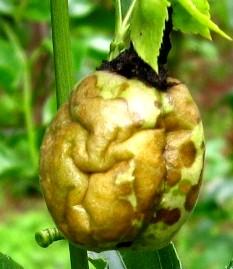


Phytophthora blight (Phytophthora nicotianae var. parastica)
Affected leaves are water-soaked and light-brown in colour. They fall readily, leading to defoliation of the vines. Affected areas of the stem are first purple and later brown above the graft union. They may completely girdle the stem causing wilting and collapse of the vine. Fruit symptoms comprise of large, water-soaked areas. Diseased fruits fall readily and in wet weather become covered with white, fungal growth.
Another strain of the fungus (Phytophthora cinnamoni) causes root rot. Yellow and purple varieties have different patterns of susceptibility. The yellow vine is susceptible to P. cinnamoni, and the purple vine is more susceptible to P. nicotianae. Both fungus strains attack both passion fruits and can cause root rot, wilt, damping off and leaf blight. Fungal spores are initially produced in wet soil beneath the vines and are splashed up to lower leaf canopy.
The disease is favoured by wet, windy weather.
- Good field sanitation.
- Pruning and keeping a grass sward under the vines to minimise spore splashed up to the lower leaves.
- Graft to resistant rootstocks (e.g.) P. caerula.
- The application of copper-based fungicides every 2-3 months during the wet season reduces disease incidence in areas where the disease is likely to be serious. Stem lesions may be painted with a copper fungicide. For more information on Copper-based fungicides click here
